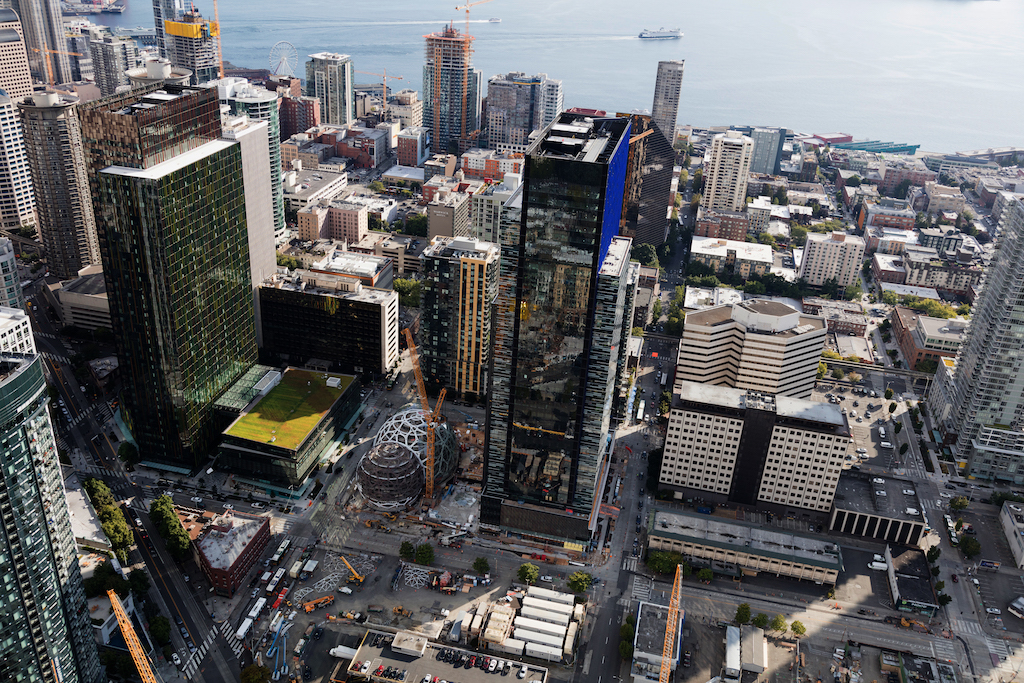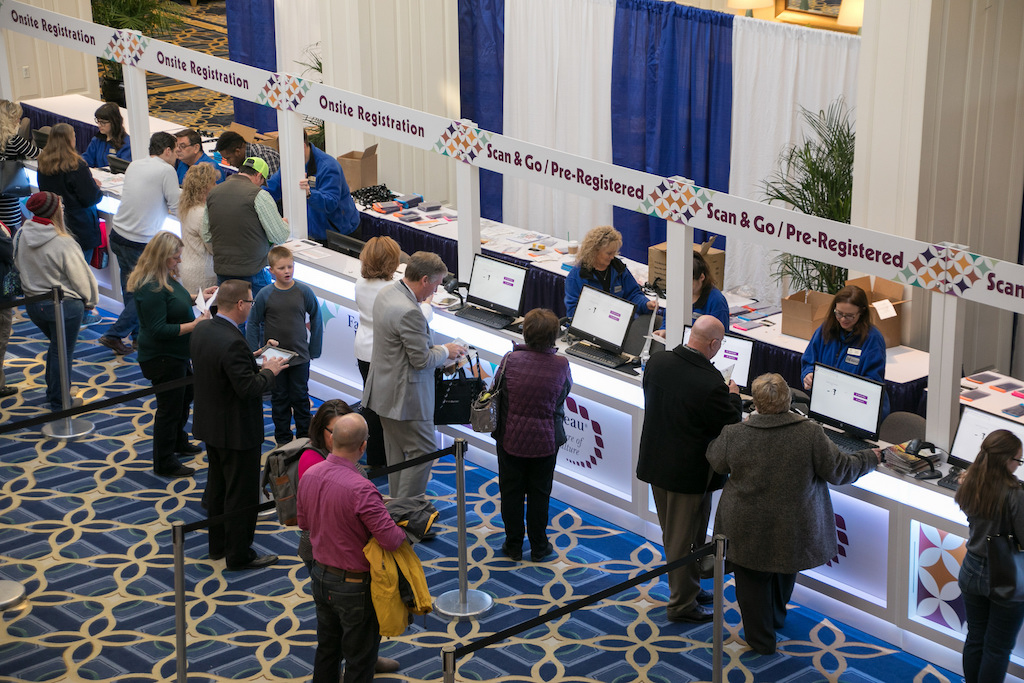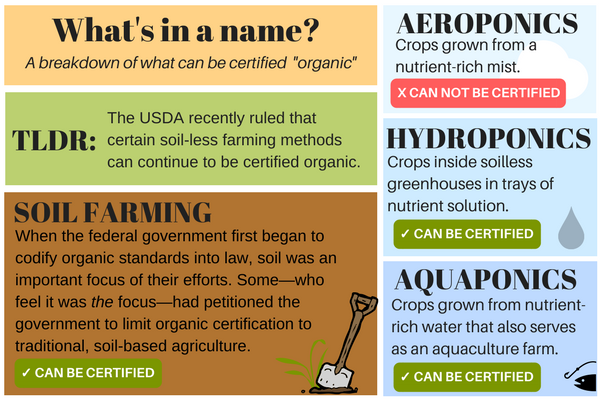
Amazon
In the spring of 1994, Seattle was still a haven for flannel-wearing weirdos, known best as the world’s biggest net exporter of sour, stompbox-flavored music. But its fortunes started to change on July 5, 1994—exactly three months after the death of grunge icon Kurt Cobain—when a Princeton-educated hedge fund manager named Jeff Bezos founded a little something in his garage. Not a band, of course, but an online bookseller named Amazon. And the city’s never been the same since.
As Amazon has grown from its early dot-com-era origins into one of the largest companies in the world, its physical footprint has ballooned as well. The company’s 33-building headquarters in downtown Seattle takes up 8.1 million square feet and employs more than 40,000 people. (With an annual payroll of $25.7 billion, the average salary works out to about $625,000 per year.) When Amazon moved to its current location in 2010, it joined only six other Fortune 500 companies. Now there are 31. Whether or not it’s been good for Seattle, business has been good for Amazon. And the company has finally decided it’s outgrown its origin city.
By now, you’ve heard that Amazon is looking for a home for its second headquarters. In a Request for Proposal (RFP) posted on its website this month, the company outlined what it’s looking for in a suitor city, like the corporate version of The Bachelorette: Existing building infrastructure of at least 500,000 square feet. One-hundred acres of pristine, undeveloped “greenfield” land—no more than two miles from a highway, 30 miles from a major population center, and no more than 45 minutes from an international airport. And plenty of local Ph.D.s. “A highly educated labor pool is critical,” the RFP declares. “And a strong university system is required.”
 Amazon
Amazon Amazon’s first office building, in Seattle’s Bellevue neighborhood
In theory, there’s nothing unusual about this. State and federal governments routinely give corporations financial incentives—usually in the form of targeted tax breaks—to help lure them to come to town. A 2014 report from the progressive-leaning think tank Americans for Tax Fairness, for instance, found that Walmart benefited from an average $70 million a year in “economic development subsidies” from state and local governments. The idea is that a company will bring so much activity to a city that the tax breaks, ultimately, will more than pay for themselves. And that’s the case that Amazon’s making here. The company is pledging to spend $5 billion developing its new headquarters, and to hire as many as 50,000 new employees over the next 10 to 15 years, who it says will make an average compensation of more than $100,000 each.
That’s a lot of influx and outflow. And cities seem to think it’s a good deal, falling over themselves to make their cases that they’re the right landing pad for Amazon headquarters 2.0.
But here’s the question: What kind of incentives will Amazon be asking for in return? And will the tradeoffs be worth it?
It’s hard to say exactly. But the RFP signals that they will play a big role in the company’s decision on location. In a section of the RFP titled “Key Preferences and Decision Drivers,” the company lays out a tax break wish after its “Site/Building” requirements, but before its list of demands related to location, labor, and quality of life. Remember the $5 billion in capital expenditures Amazon promised up top? Looks like the company doesn’t want to front all that cash itself. “Incentives offered by the state/province and local communities to offset initial capital outlay and ongoing operational costs will be significant factors in the decision-making process,” reads the RFP. In other words, Amazon hopes its new home city will subsidize its operational costs—not just up-front, but on an ongoing basis.
But that’s not all. The “capital and operating costs” bullet is followed by a second section:
 Amazon
Amazon Here, Amazon’s signaling that it wants to see a raft of potential incentive options, including money related to land and construction, corporate taxes, labor, utilities, and permitting. The company makes clear that these considerations will be “critical” in its choice—a word it uses only three other times in the document. (Other factors described using that language: a highly educated labor pool, easy travel in and out, and ability to move forward on a quick timetable.)
Still, the company is offering to spend a lot of money. So how can cities know they’re getting a good deal?
According to Timothy Bartik, a senior economist at the Kalamazoo, Michigan-based, non-partisan research company W. E. Upjohn Institute, corporate incentives usually amount to about a 3-percent wage subsidy. In other words, the employer receives 3 cents in tax breaks for every dollar it spends on salary. The deal may be structured differently—through property or corporate income taxes, for example—but the 3-percent figure is one that economists often use to calculate the standard benefit corporations receive. What would that mean in Amazon’s case? If the company is true to its word and hires 40,000 employees, each making an average of $100,000 a year, a 3-percent wage subsidy would work out to a tax break of $150 million a year.
That’s a lot of money to spend on a company that already has plenty of it. Amazon is one of only five $500-billion corporations in the world. (Guess what? They’re all in tech.) But the question isn’t really whether or not taxpayers should be galled by the idea of subsidizing an e-retailer helmed by the world’s second-richest man. It’s about how much bang they’d be getting for their buck.
It’s hard to say whether corporate incentives are typically worth what we, the people, pay. States, in fact, don’t even know themselves. A 2014 Pew Center on the States study on the topic, “Evidence Counts,” found that:
“…no state regularly and rigorously tests whether those investments are working [or] ensures lawmakers consider this information when deciding whether to use them, how much to spend, and who should get them. Often, states that have conducted rigorous evaluations of some incentives virtually ignore others or assess them infrequently. Other states regularly examine these investments, but not thoroughly enough.”
In other words, states really don’t know whether the corporate freebies they give away have a good impact, a bad one, or something in between. The decision, as Slate’s Henry Grabar points out, is more often a political calculation than an economic one. It simply looks good to be the dealmaking governor or mayor that brought [insert company name here] to town.
And the research that does exist tends to skew negative. An analysis of New York Times data by CityLab’s Richard Florida and the University of Toronto’s Martin Prosperity Institute found “virtually no association between economic development incentives and any measure of economic performance”—including wage level, education, and unemployment rate. The only correlation Florida did find was with poverty: Places that had offered more incentives tended to be poorer. Correlation doesn’t prove causation, as we all know, but this is still not a rave review.
 Amazon
Amazon Amazon’s Seattle campus, in both the downtown and South Lake Union neighborhoods
First, he says, it helps for the incoming company to be a strong supporter of local supply chains. This means that businesses in the manufacturing industry tend to be good candidates, because they usually become ongoing customers of locally made materials and parts, and it’s efficient for them to buy from suppliers nearby. Amazon isn’t a great fit in this category, as its product, at heart, is digital tech. Sure, it’s going to need to buy a huge number of desks and room dividers, but it’s unlikely to buy those things locally. It’s more likely to shop the way we all do on Amazon: looking only at price. Location be damned.
The second factor to look at, Bartik says, is whom the company is hiring and how much it will pay. If a company is going to hire locally, that can be great for the state. While Amazon is likely to field local talent where it can get it—one area where proximity to universities will help—the tech industry’s cutthroat competitive culture demands that Amazon bring in world-class talent wherever it can find it. Then there’s those $100,000 per year jobs. Well-paid people obviously have more money to spend, which can have economic benefits locally. But Bartik says far more important to consider is whether a company is providing a wage premium—paying more for jobs of that caliber than other companies would. Amazon’s salaries will surely be competitive, but will it pay more than other tech companies of its ilk? Probably not, and the premium there will be enjoyed mainly by the wealthy. In both measures, Amazon falls short.
A third factor Bartik cites is a company’s ability to create a “cluster” economy—in other words, lure new businesses to a region because they want to do business with Amazon. (We reported on an example of this in North Carolina: a “confectionary cluster.”) That’s one area where Amazon might shine, in theory. Restaurants could set up shop to wait on its well-heeled young employees, or other digital businesses might also follow suit. If Amazon can launch the next Silicon Valley in Denver, say, there could certainly be economic value there. Though Bartik says there are no good estimates about how tech clusters work, and what kind of overall economic value they provide.
According to Bartik’s criteria, Amazon seems like a below-average contender for incentives—even considering it’s receiving the standard benefit, the 3-percent wage subsidy. But there are signs that Amazon may ask for—or get without asking—far more. We’re living in an era of mega-incentives deals, as Slate points out: Nevada has provided Tesla with $1.3 billion in incentives, and Washington State bestowed upon Boeing a stunning $8.9 million. Then there’s Wisconsin’s whopping, widely derided FoxConn deal: $10 billion provided to create only 13,000 jobs in return.
Bartik says that offering Amazon anything better than the standard deal would likely be economic folly and that academics in economic development circles refer to a maxim that’s like the reverse of the Lay’s potato chip slogan: with economic incentives, no one can give just one. In other words, if Amazon gets a plush deal, then other companies will come asking for one, too. What if new, enterprising, grassroots nonprofits devoted to hiring the city’s chronically underemployed are shut out from any substantial public subsidies because —in the wake of such a mega-deal—there is nothing left in the municipal till?
The situation can quickly become politically untenable.
And though local governments may be lured by the sheer size and scope of the new project. Bartik says that scale shouldn’t really be a factor in decision-making around corporate incentives. You could give the same money to 10 smaller tech companies, or 100 if they were spending and hiring a proportionate number. Why should Amazon get all the benefit, just because it’s big?
Finally, there’s just a very basic factor to consider: is a major influx of tech jobs as good a thing for cities as we think? The verdict’s still out on that, though the Bay Area has obviously seen a host of social issues as housing costs rapidly rise, driven by the flood of tech profit and talent. And look at Seattle: Between 1992 and 1993, it was the metro area where incomes in this country rose the least. Now, thanks to Amazon and Starbucks, and other Fortune-500 companies, the city’s incomes are among the fastest-rising in the nation.
In a 2014 op-ed quoted by Business Insider, Jeff Reifman wrote that, with Amazon ascendant,
“Seattle will be more male, even more white, wealthier and less diverse, unaffordable to those with lower incomes including the firestarters of culture, artists. The city’s spacious skyline, which offered scenic views from many areas of town, will be forever transformed; anyone who lives here knows it already has been. Many parts of Seattle are unrecognizable from last year let alone a few years ago.”
So consider that scenario, all you 2nd-headquarter contestants on The Bachelorette: Amazon Edition. And one last thing: A 2011 Lincoln Institute of Land Policy study found that, most of the time, companies that have been granted incentives would in fact have moved to the same location anyway.
You don’t have to give it all up for free.










